Leonard Splaine HVAC System Service & Repair Serving Northern Virginia Since 1956

First Things First: What is an HVAC System?
Most everyone has heard the term “HVAC system”. But what is it, really?
The technologies that make-up your HVAC system - Heating, Ventilation and Air Conditioning - are the systems that ensure the quality and comfort of our home’s indoor environment.
Each component has its role to play: Your heating and air conditioning systems each regulate your home’s temperature to keep it within a comfortable range of warmth in the winter and cool in the summer. Nowadays, in most residences, both systems work through a centralized system.
Ventilation’s role is to both keep your interior air circulating throughout the space and to replace indoor air with fresh, outdoor air. By both circulating air throughout your house and replacing it with fresh air from the outside, ventilation works to increase oxygen levels, remove carbon dioxide and other noxious gases, remove excess moisture, dust, smoke, and odors, and, to a degree, modify internal air temperatures.
Efficiency: What is it, Really?
HVAC isn’t the only acronym you’ll run into when shopping for a new heating system. AFUE, SEER, EER, HSPF are all terms that refer to various ways to measure how efficient they are at getting heat (or cold) from fuel.
So, let’s start with the basics: “efficiency” is simply how much heat is extracted from a quantity of fuel. In other words, efficiency= energy out divided by energy in.
Heat is measured in “Btu” or “British thermal units”. 1 Btu is equal to how much energy you need to raise the temperature of 1 pound of water by 1 degree fahrenheit. 1 KWh of electric power, for example, yields 3413 Btu.
Because electric space heaters radiate all their heat out into the room they are heating, they are 100% efficient: you’ll get exactly 3413 Btu of warmth for that 1 KWh. On the other hand, 1 cubic foot of natural gas is equal to 1000 Btu.
If a manufacturer tells you their furnace is 90% efficient, they are really telling you that for every 1 cubic foot of gas their furnace burns, it will extract 900 Btu of heat from that cubic foot of fuel to warm your home. 100 Btu will be lost up your chimney as exhaust heat.
So why not make all furnaces electric or heat your home with electric space heaters?
Because every Btu from electricity costs you more than a Btu from natural gas. Electricity is more expensive than gas.
So while electric heaters use energy more efficiently, it would cost you much more to heat your entire home electrically than it would using gas, even if your gas furnace isn’t 100% efficient
Alphabet Soup: Understanding Efficiency Ratings
AFUE
Annual Fuel Utilization Efficiency (AFUE) measures how efficient a furnace or boiler is over an entire heating season.
Because colder the weather puts higher demands on equipment than less extreme temperatures, AFUE tells you your furnace or boiler’s average efficiency over the course of a typical winter.
The chart below illustrates the increased energy savings with higher AFUE ratings. Whereas you get zero energy savings at 60 AFUE, 80 AFUE will save you 20% off your energy bill while 95 AFUE offers a 33% energy savings.
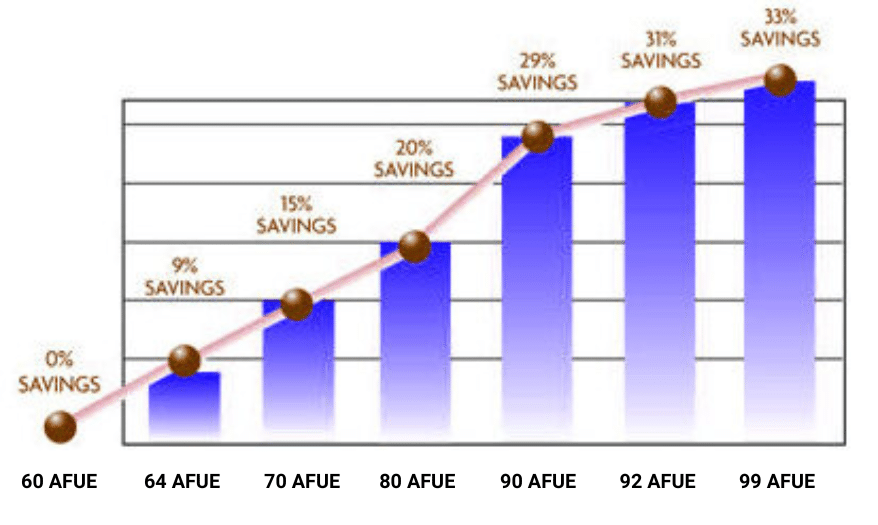
Higher AFUE equals greater energy savings
HSPF
Heat Seasonal Performance Factor (HSPF) is most commonly used to rate efficiency of air heat pumps.
A heat pump’s HSPF number is its total heat output in Btu (including supplementary electric heat) over the course of a normal heating season divided by the total mount of electricity used (in watt-hours) over that same period.
The higher the HSPF, the more efficient the heat pump.
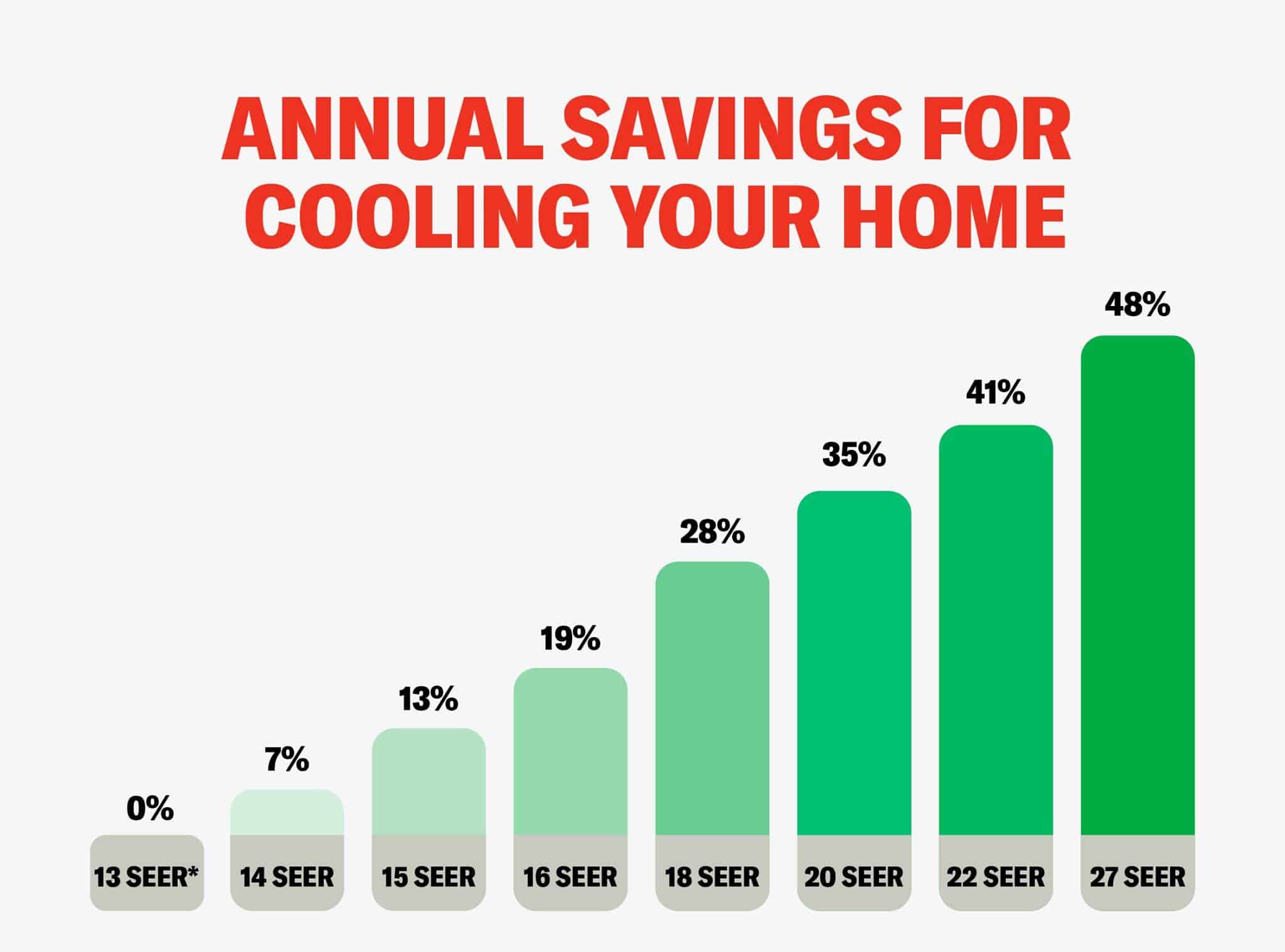
Annual Savings for Heating Your Home Based on HSPF Rating
SEER & EER
SEER and EER refer to how efficient a heat pump or air conditioner is at cooling or, in other words, removing heat. Because cooling is the removal of heat, SEER & EER are expressed in Btu.
The SEER number is the total cooling capacity produced over an entire cooling season measured in Btu divided by the total electric energy (in watt-hours) consumed by the heat pump or AC unit to produce it.
SEER is specific to efficiency in temperate climates in the middle of the U.S.Energy Efficiency Ratio (EER) is a measure of cooling system efficiency when operating at an outdoor temperature of at 95 degrees F.
In technical terms, EER is the steady-state rate of heat energy removal (i.e. cooling capacity) per hour divided by the steady-state rate of energy input to the product measured in watts.
So, the SEER rating more accurately reflects overall system efficiency on a seasonal basis while EER reflects the system’s energy efficiency at peak day operations.
Like with HSPF, the higher the number for SEER & EER, the more efficient the system. Both ratings are important when choosing a product.
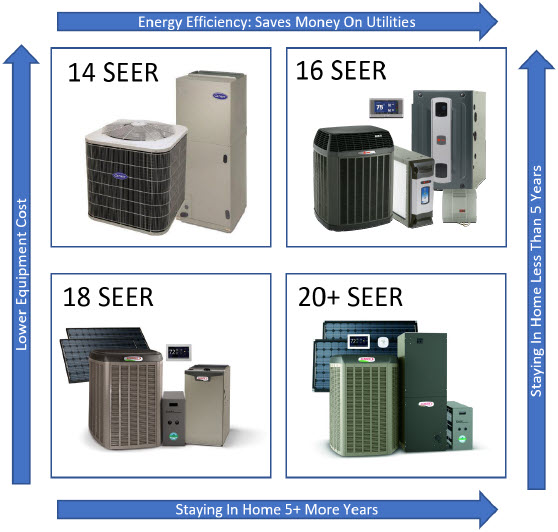
The Importance of Selecting the Right HVAC System for Your Needs
We all know that heating or cooling our homes is expensive. But just how expensive can it really get? As the illustration below illustrates, when you realize that energy to power your heating and colling systems as a percentage of your total annual household expenses, is 49% it can get pretty expensive!
That's why ensuring you have the best HVAC system for your home is so important and is well worth the time and effort required to buy the best available system available for your needs and to ensure you maintain it for optimal performance.
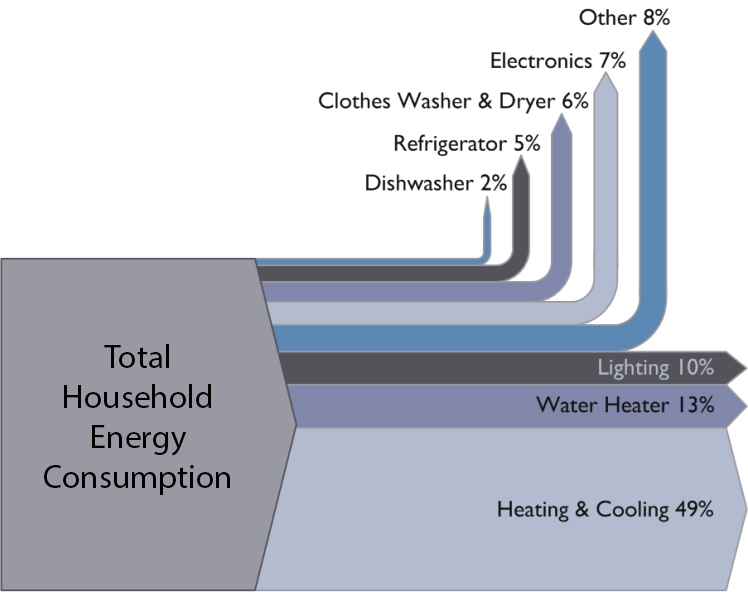
Looking for a New HVAC System or Does Your HVAC System Need Service?
Are you interested in a new HVAC system or does your existing HVAC system need service or a tune-up? Then give our team of experts at Leonard Splaine a call today.

What is a Central Heating System?
You could use individual room heaters and window AC units to heat & cool your home. But, effi-ciency-wise, both in equipment & fuel costs and maintenance, to use centralized systems instead.
Centralized residential heating/cooling has four main components:
Central Unit
Typically made up of a furnace and A/C unit plus a boiler or heat pump. These are the fuel burning centers of your HVAC system.
Distribution System
This is the ductwork in forced air systems or pipes for water/steam systems. Their job is to carry heat/cold from the central unit and through the house.
Venting System
Comprised of vents and pipes that vent spent air and the poisonous gases made in the central unit by burning fuel out of your house.
Thermostat
This is the brain of the centralized system, controlling the entire system.
Because furnace and boiler-based heating systems generate heat in a central location and then distribute it throughout the house through a duct system, they are often referred to as “central heating systems.”
Furnaces: Types and Efficiency Ratings
Furnaces are a type of heating unit. They are manufactured to use various types of fuel: solid fuels, like coal burning stoves; liquid fuels, like oil burning furnaces; gas such as natural gas or propane burning furnaces, and electricity in the case of electric heaters.
Gas Furnaces
Modern central heating systems, are typically equipped with gas powered furnaces. In the last decade, efficiency scores for these units have increased from 65% to as high as 95%!
Natural gas is the most common home heating fuel in the U.S., used in 57% of American homes.
Gas furnaces are made up of a burner, an ignition device, and one or more heat exchangers. The exchangers are where the heat generated from the burning gas transferred to the in-door air the is circulated through the unit and the exhaust gas produced by the burning fuel is transferred to the venting system. Once warmed, a circulation blower moves this heated air throughout your house.
Manufacturers have focused on designing the heat exchangers to extract as much heat as possible from the hot gases and exhaust before venting them out of the home.
Mid-efficiency furnaces can now extract between 78% to 83% heat before venting.
Ultra-high efficiency furnaces - with ratings of 90% to 97% efficiency - actually add a second heat exchanger to extract even more heat from the relatively cool exhaust after it leaves the first exchanger.
Extracting heat at these cooler temps, causes water vapour to condense out of the exhaust, which is why these furnaces are called “Condensing Furnaces.”
Oil Furnaces
These are very similar to gas furnaces in operation and have similar efficiencies.
The difference lies in fuel combustion: with liquid fuel, oil furnaces have a fuel atomizer that gets mixed with hot combustible air and forced into the combustion chamber.
While not as common and condensing gas furnaces, condensing oil furnaces are available, with efficiency ratings above 90%.
Electric Furnaces
Electric furnaces convert electricity into heat using an electric resistance heating coil. The coil is housed in a cabinet with a circulation blower that transfer the heat to the circulating indoor air.
Electric furnaces are very near 100% efficient - only a very small amount of heat is lost through the cabinet.
But, given that electricity is typically very expensive relative to other fuels, electric furnaces aren’t recommended for central heating.
Heat Pumps: Types and Efficiency Ratings
Heat pumps, air conditioners, even your refrigerator all work the same way: they move heat from where it is to somewhere else.
Your refrigerator pumps heat from inside your fridge out into the room. Your AC pumps the warmth in your house outdoors and your heat pump does the reverse.
In fact, combination AC/Heat Pumps are dual purpose: using a flow control valve that re-verse the flow of air, the same equipment both pumps heat out of your house to cool it and into your house to warm it as the season requires (see diagram below).
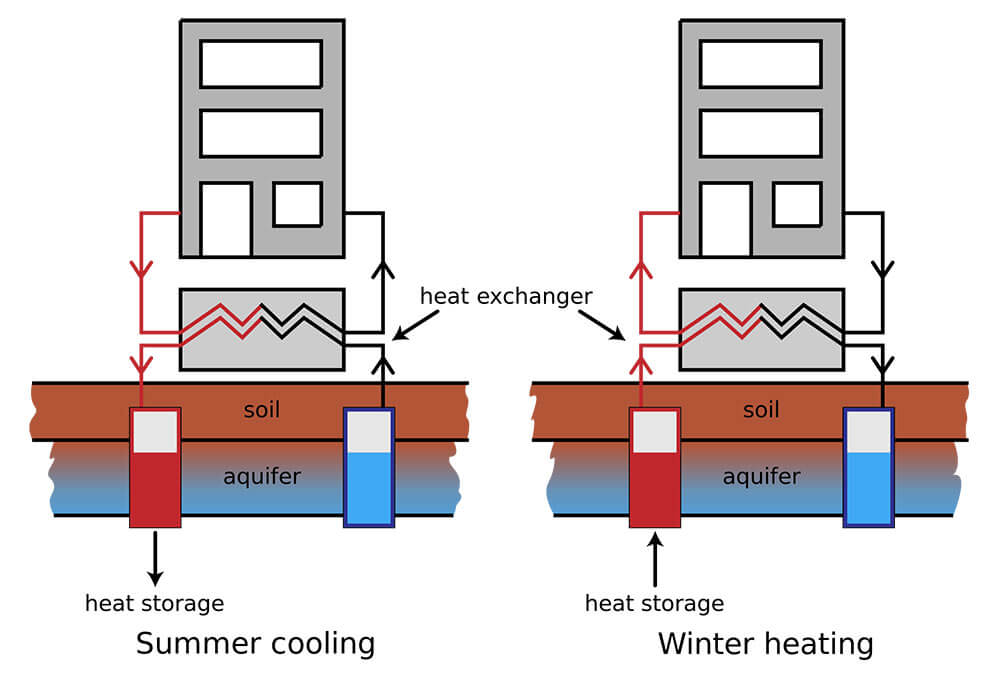
Heat and Cold Storage with a Heat Pump
This adaptability is a prime advantage of heat pumps and makes them extremely popular in temperate climates that experience both extreme heat and cold such as we have in Virginia.
All heat pumps are made of the same components: an indoor coil to heat or cool circulating house air; and outdoor heat source to supply the heat or cool, copper tubing to circulate pressurized refrigerant between the indoor and outdoor units and finally, a compressor which does the actual air “pumping” (See diagram, below).
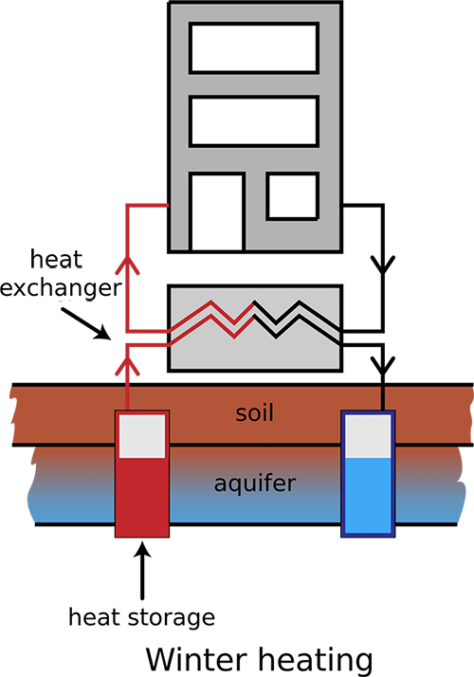
Geothermal Heat Pump for Winter Heating
These systems are extremely good at their job. In fact, a heat pump is able to capture heat within the range of 20 to 30 degrees F and use it to heat indoor air to a warmth of between 80 to 100 degrees F.
Types of Heat Pumps
Consider how the heat pump sources its heat, there are two main types: air-source or geothermal. We'll look at each in turn below.
Air-Source Heat Pumps
As the name implies, an air-source heat pump extracts heat from the outside air and uses it to heat and circulate indoor air via a heat exchanger and fan.
To deal with extreme temperatures, these heat-pumps are equipped with a two-stage thermostat.
If your home’s indoor air temperature drops below a few degrees of the setting, the heat supplied by the pump’s compressor is supplemented by heat generated by a electric resistance coil.
It’s this reliance on a supplemental electric heat source that dramatically reduces a heat pumps efficiency.
In temperate climates, electric resistance heat would come into play only when the outside temperature drops to around 15-25 degrees F or when turning the heat pump in a cold house.
Another factor reducing n air-source heat pump’s efficiency is that frost forms on the outdoor heat coil when temperatures drop to 40 degrees or below.
A build up of frost will impair the transfer of heat to the coil markedly decreasing the heat pump’s output and efficiency.
Heat pumps have a “defrost” cycle to deal with this, using indoor heat to melt the frost and warm the outdoor coil.Again, this reduced efficiency is the main disadvantage or air-to air heat pumps. Where an air-source heat pump will be operating at outdoor temperatures at or below 35 degrees F, operating costs as well as home comfort drops, because the heat pump isn’t able to sufficiently heat the air.
While this is a troublesome problem in colder regions of the country, it is not a severe problem in most regions of Virginia.
Geo-Thermal Heat Pumps
Geothermal heat pumps use ground heat as their energy source. Ground heat is extracted via water circulating in a closed-loop pipe buried in a deep trench or well.
Because the deep-ground temperature is constant year-round, Geothermal heat pumps are more efficient than air-to-air heat pumps.
Because the ground is also warmer than cold winter air, GHPs are more efficient than Air-to-air HPs because they pump heat over a smaller temperature range. The result is GHPs use 25-50% less electricity than conventional heat pump systems.
They are also more efficient when operating as AC units, as they only have to pump heat into the relatively cooler ground than hot, summer air.
Beyond their increased efficiency, GHPs have better humidity control, run quieter, are more durable with less maintenance and are greener, requiring less energy to operating.
The disadvantage with Geothermal HPs is their installation cost. But where you’re installing a system for a new build or replacing an outdated system in your forever home, their lifetime efficiency in both energy use and maintenance costs makes them a good long-term investment.
How Heat Pumps Work
How a heat pump works depends on whether it is set to heating or cooling. We'll use the example of how an air-Source heat pump works below. The same general processes apply to geothermal heat pumps with variation in the system's components.
The Heat Pump Heating Cycle
When heating, a heat pump takes heat from the outdoor air and "pumps" it indoors.
Steps:
- First, liquid refrigerant passes through the expansion device, changing to a low-pressure liquid/vapour mixture.
- The refrigerant then moves to the outdoor coil, which acts as an evaporator coil.
- The liquid refrigerant absorbs heat from the outdoor air at this stage, causing it to boil and become a low-temperature vapor.
- The resultant vapor passes through the reversing valve to the accumulator, which collects any remaining liquid before the vapor enters the compressor.
- In the compressor, the vapor is compressed, reducing its volume. This pressure causes it to heat up.
- Once heated, the reversing valve passes the now hot gas to the indoor coil which acts as the condenser.
- Indoor air passes over the indoor coil, transferring the heat to the air. Note that the indoor coil is located in the ductwork, close to the furnace.
- The now cool refrigerant vapor condenses back into liquid, and returns back to the expansion device.
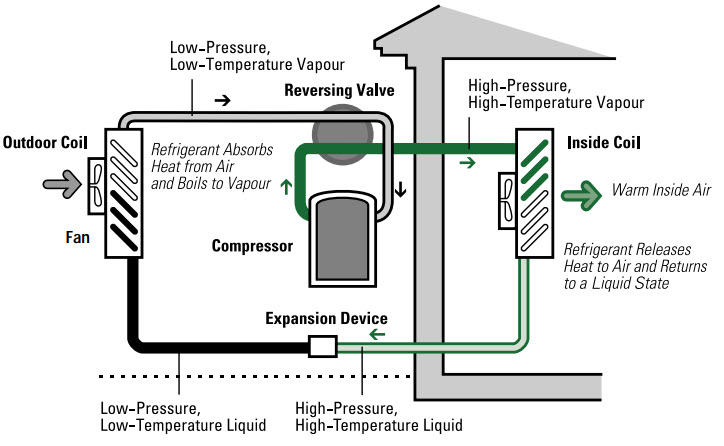
Diagram illustrating the components of an air-source heat pump heating cycle
Air source heat pumps are limited in their ability to heat a home by the ambient outdoor temperature. What this means is as the outdoor temperature gets colder, the less heat there is for the air-source heat pump to absorb and thus to generate. Below this outdoor ambient temperature, the heat pump can supply only part of the heat required to keep the living space comfortable, and supplementary heat is required.
For newer air-source heat pumps, this can range from between -15°C to -25°C.
The Heat Pump Cooling Cycle
The heating cycle described above is reversed to cool the house in hot weather. That is, the unit takes heat out of the indoor air and moves it outside.
- As with the heat cycle, the liquid refrigerant first passes through the expansion device, changing to a low-pressure liquid/vapor mixture.
- However, it then goes to the indoor coil, which now acts as the evaporator rather than the condenser.
- The liquid refrigerant absorbs heat from the indoor air and boils, becoming a low-temperature vapor.
- Again, the vapor passes through the reversing valve to the accumulator.
- The accumulator collects any remaining liquid, while the vapor moves on to the compressor. The vapor is then compressed, reducing its volume and causing it to heat up.
- The now hot gas passes through the reversing valve to the outdoor coil, which in the cooling cycle acts as the condenser.
- The heat from the hot gas is transferred to the outdoor air, causing the refrigerant to condense into a liquid. This liquid returns to the expansion device, and the cycle is repeated.
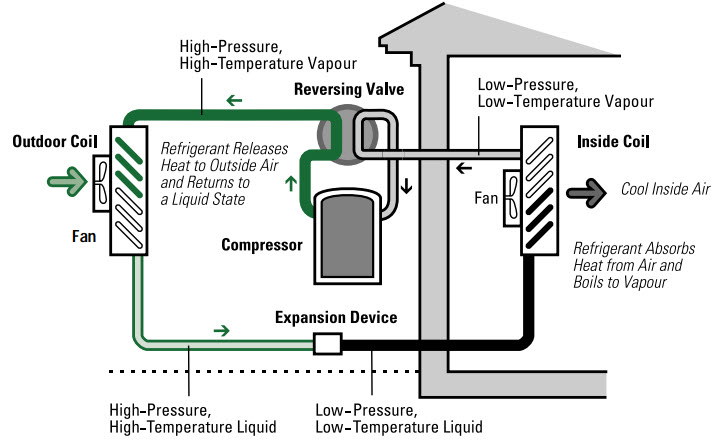
Diagram illustrating the components of an air-source heat pump cooling cycle
During the cooling cycle, the heat pump also dehumidifies the indoor air. Moisture in the air passing over the indoor coil condenses on the coil's surface and is collected in a pan at the bottom of the coil. A condensate drain connects this pan to the house drain.
When to Consider Heat Pumps as Your HVAC System
Factors to consider in determining if a heat pump makes the most economic sense for you include the following:
Your location's climate
Heat pumps are most suited to moderate climates. Again, if your area experiences extreme cold, a heat pump alone will cost substantially more to heat your home on its own, necessitating some form of supplemental heating - such as a furnace or ductless heaters for localized heating. While these will offset the cost of operating the heat pump to generate heat, the cost of the heaters themselves will add to your initial cash outlay.
Home's age and time-horizon
Do you have a newer home insulated with higher R-value materials? If yes, your home’s ability to retain heat will result in reduced loading of the heat pump and could potentially mean a supplemental heat source isn’t required to generate additional heat and maintain warmth at a reasonable cost.
Alternatively, if you have to supplement your heat pump with a heat-generating appliance because your home doesn’t have a high R-value, a heat pump may still make sense if you plan on living in that home for a longer period of time. Because of the heat pump’s running efficiency, the savings you get from its operation, only supplementing with extra heat when necessary, can offset the cost of the heater over time.
Rebates and tax-credits
You can obtain a 30% federal tax credit when you purchase and install an Energy-Star rated geothermal heat pump.
You may also obtain state tax credits and manufacturers may also offer seasonal incentives.

Our 100% Satisfaction Guarantee
We're so confident you'll find us to be a company you can rely on for all your heating and air conditioning needs that we guarantee your complete satisfaction! Contact us today and experience the difference for yourself.
What are Ductless HVAC Systems?
While “central heating” (and cooling) usually refers to HVAC systems with a centralized heating/cooling unit, whole home temperature control doesn’t require a ducted system for distribution. Instead, ductless heat pumps and air conditioners consist of wall-mounted indoor units combined with an outside compressor.
Most homeowners typically consider going the ductless route when replacing an HVAC system in a home without ducts. But with the advantages these systems offer, they are increasingly seen as a whole home option in new builds as well.
In fact, because the average home loses 25% or more energy to duct leakage, eliminating the need for ducts makes these systems exceedingly energy efficient right off the bat.
Because ductless system compressors operate on a “revving” basis - meaning they speed up & slow down depending on the needs of the system rather than shutting down & starting up like com-pressors do in typical heating systems, a ductless system can save you up to 30% on energy costs.
Additionally, like with the purchase of ENERGY STAR rated heat pump systems, if you opt for ductless HVAC, you may qualify for a federal tax credit and local utility incentives as well.
Benefits of Ductless HVAC Systems
Ductless HVAC can offer many benefits versus ducted solutions in the right situation, including:
Flexibile Solutions
Ductless systems are comprised of a small outdoor unit and one or more indoor units. To op-erate, unit mounting and access to electricity is all that is required to deliver heated or cooled air directly into different zones and at whatever temperature is preferred in that specific area.
Traditional heat pumps and central air conditioning systems on the other hand force cooled and heated air from a central unit through ductwork built into the walls of the house. When turned on, you’re heating or cooling the entire the house and not just a specific area.
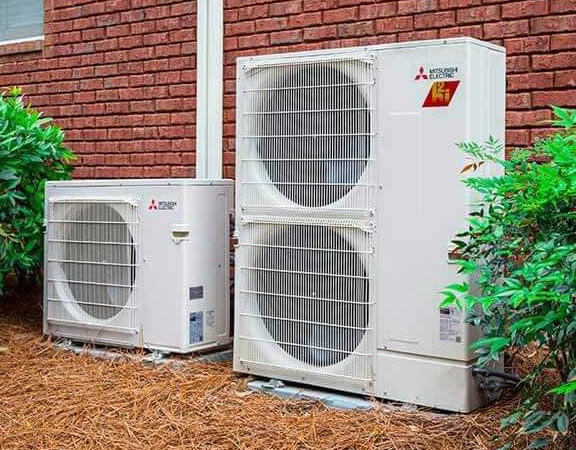
Multi-split outdoor Mitsubishi units
They Save You Money
One of the biggest reasons why homeowners switch to ductless cooling and heating is overall cost savings.
Because ductless systems operate on less power – they are smaller than traditional forced-air systems, and because the temperature-controlled air is delivered directly into a room, there is no loss in efficiency.
Multi-split systems also allow homeowners to create “zones” in their home, which means they no longer have to cool or heat rooms that aren’t occupied.
Purchasing a system may also qualify you for tax credits or utility rebates for the year they install a ductless system, offering even further savings by subsidizing their purchase cost.

Diagram showing Zoned-areas of a house with a ductless HVAC System
Improved Indoor Air Quality
To maintain indoor air quality, traditional HVAC systems require regular professional clean-ing. Even so, forced air systems often result in dust and allergens.
On the other hand, ductless systems offer multi-stage filtration that can drastically reduce dust, bacteria, pollen, allergens and other particulates in the air.
Quick and Easy to Install
Unlike traditional ducted systems, multi-split ductless systems run on small pipes that re-quire a mere three-inch hole, you don’t have to worry about rebuilding walls or ceilings around ductwork and there is no loss of square footage for unit installation.
Ductless systems are far less invasive to install than traditional HVAC systems. In fact, de-pending upon the number of indoor and outdoor units required your new system can be up and running in as little as one day.
Reduced Carbon Footprint
The small size of a ductless cooling system and the ability to cool by room or “zones” allows for greater energy efficiency.
Ductless cooling and heating systems are also built to ENERGY STAR guidelines, which means they are far more energy efficient than the minimum standards set forth by the U.S. federal government.
Additionally, ductless systems use a refrigerant called R410A, which is known for its zero ozone depletion potential. This means the system will have less impact on the environ-ment throughout its lifecycle.
Considerations of Ductless HVAC Systems
Some things to keep in mind when looking at a ductless heating system solution.
Up front Costs
Up-front costs will be several times more than that for a baseboard heating unit or window air conditioner in a single room or for replacing an existing central heating/cooling system with a ductless one.
Substantially increased efficiency will provide payback - up to 30% lower energy bills for heating and cooling in fact, but the timeframe to making up the difference depends on your climate, how you use the system, and your local electricity rates.Also keep in mind that extremely cold climates will most likely require a backup, fuel-based system to take over when temperatures fall below zero.
To work out whether a ductless system makes economic sense for you, find a reputable HVAC contractor knowledgeable about system sizing calculations and who will tell you whether you will need a secondary system in your area.
Monthly Maintenance
To function at peak efficiency, each unit’s filter must be washed on a monthly basis - more often if you smoke or have pets.
Because ductless fans can’t handle a build-up of dust and debris, the importance of filter maintenance can’t be overstated.
Ignoring simple regular filter maintenance will result in having to pay for professional cleaning down the road and, because of the extra strain placed on the units’ fans, could even shorten the life of your system.
Aesthetics
Some feel the units can detract from their decor.
Design options are certainly limited - units come in standard white or beige and can’t be covered up. However, once installed, because of their mounting height and silent operation, most users usually report the unit tends to blend into the background.
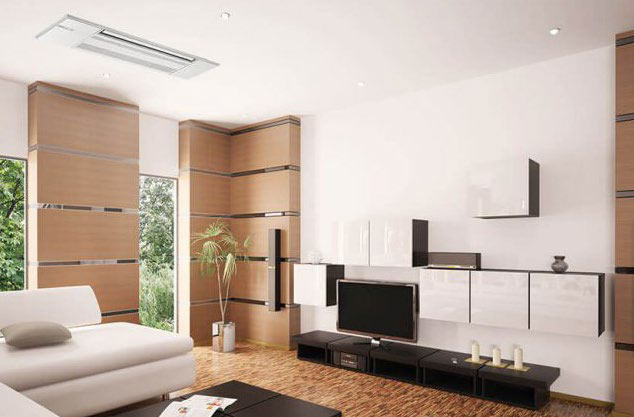
Example of a ceiling mounted ductless unit
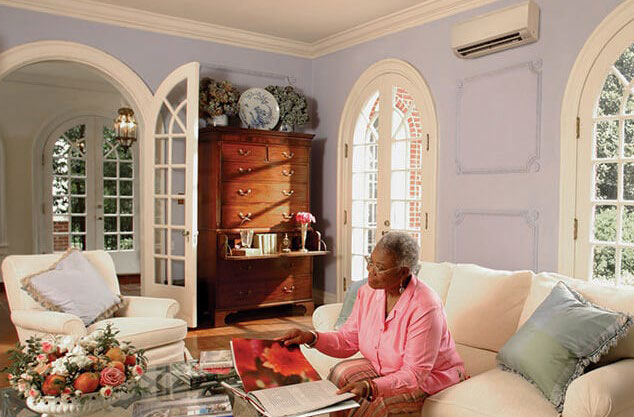
Example of a wall-mounted ductless unit
When is Ductless Your Best Solution?
While ductless systems as a whole house heating and cooling can make sense depending on a number of factors, there are certain situations where ductless holds a clear advantage over other types of HVAC solutions, including:
Adding Central AC without Ducting
While ductless solutions aren’t cheap, it’s less extensive than adding ductwork to an ex-isting house.
Opting for a ductless AC system will not only save you money over installing ducting, but it will also offer better interior and exterior aesthetics and efficiency over window AC units.New Additions to Existing Builds
Garage apartments, bonus rooms, sunrooms, and “man caves.”
As new additions to existing builds, you can take advantage of not having to connect these areas to existing ductwork.
The benefit in being able to heat and cool these areas without connecting to the existing distri-bution system is that you won’t be overloading your existing HVAC; your heating/cooling solution will be sized to fit the new space; and you can isolate odours from other areas of the home.
Downsizing in Larger Homes
If kids have moved out and you’re in a position where you don’t want to heat and cool areas of your home, you may be tempted to simply shut off HVAC grilles. But doing so will create pressure imbalances and could give rise to mold problems. A better solution would be to install a ductless system in the master bedroom and main living area and set the home’s main thermostat to run at a lower level.
We're Here to Answer All Your HVAC Questions
We've covered a lot about the types of HVAC systems available out there, but there's a lot more to consider. If you have questions about your specific needs, we invite you to reach out to us at Leonard Splaine and connect with one of our experts who will ask you the questions you will need to answer to ensure you select the right system for your unique situation!

We Are the Expert Solution to All Your HVAC & Home Comfort Needs
Take it from our customers: we solve problems and deliver solutions like no other HVAC company can. Contact us today!

